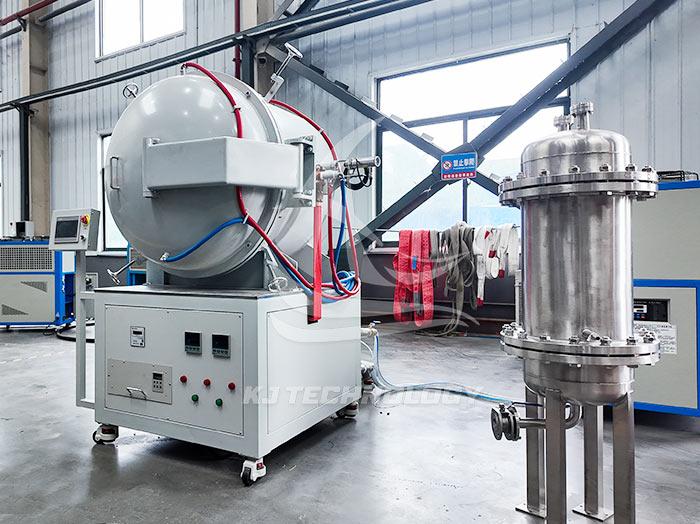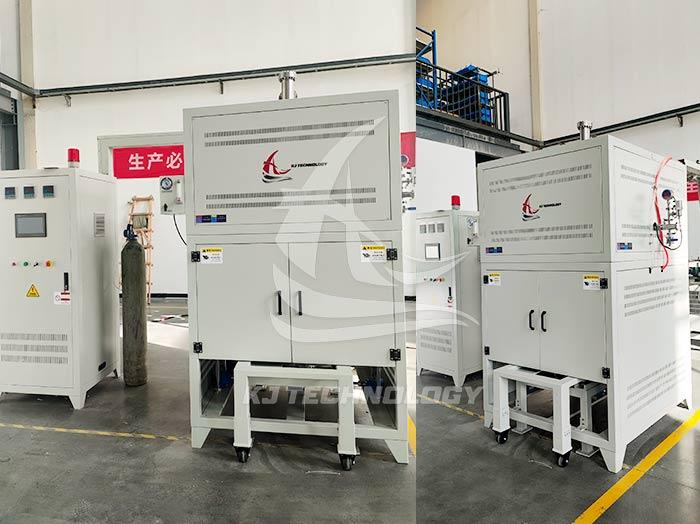Precautions for Vacuum Heat Treatment Furnace in Powder Sintering Process
 05-19-2025 Author: KJ technology
05-19-2025 Author: KJ technology
When sintering powder in a vacuum heat treatment furnace, the following precautions should be taken:
1.Equipment inspection and cleaning:
Equipment status check: Before use, it is necessary to check all components of the equipment, including the vacuum pump, heating element, and temperature control system, to ensure that they are intact and undamaged.
Furnace cleaning: Ensure that there are no impurities or dust in the furnace to avoid the production of harmful gases or affecting the sintering quality of materials at high temperatures. You can use lint free cloth and anhydrous ethanol for cleaning.
2.Material pretreatment and loading:
Material pretreatment: Before being placed in the equipment, materials usually need to be pretreated, such as cleaning, drying, pre firing, etc., to ensure that the surface of the material is free of oil, moisture, and other impurities.
Uniform distribution: evenly distribute the materials in the furnace to avoid accumulation and ensure uniform heating, thereby improving sintering quality.
Loading capacity control: Select appropriate material loading capacity based on equipment specifications and experimental requirements. Excessive loading may cause equipment overload, while insufficient loading may affect sintering efficiency.
3.Vacuum degree and atmosphere control:
Vacuum degree setting: Set an appropriate vacuum degree based on the characteristics of the material and experimental requirements, usually between 10 ⁻ and 10 ⁻ pallets.
Gradually evacuate: When starting the vacuum pump, the pressure inside the furnace should be gradually reduced to avoid material splashing or equipment damage caused by sudden pressure reduction.
4.Temperature and time control:
Temperature setting: Set the appropriate sintering temperature and heating rate. Excessive temperature or rapid heating rate may cause uneven sintering or defects in the material.
Insulation time: Set an appropriate insulation time to ensure that the material is fully sintered at high temperatures. A too short insulation time may lead to incomplete sintering, while a too long insulation time may waste energy and time.
5.Cooling process:
Gradual cooling: After sintering is completed, the temperature inside the furnace should be gradually reduced to avoid material cracking or deformation caused by sudden cooling. Nitrogen or other inert gases can be used for protective cooling.
6.Safe operation:
Protective equipment: Operators need to wear appropriate protective equipment, such as goggles, lab coats, and gloves, to cope with potential safety hazards caused by high temperatures and vacuum environments.
Operating procedures: Strictly follow the operating manual of the equipment to avoid changing parameters or performing non-standard operations at will. Especially during the heating and cooling process, it should be done slowly to avoid sudden changes.
7.Emergency Management:
Familiar with emergency measures: Operators need to be familiar with emergency response measures for equipment, such as emergency response methods in case of sudden power outages, vacuum pump failures, etc.
8.Maintenance and upkeep:
Regular inspection: Regularly inspect the vacuum system, heating system, cooling system, etc. of the equipment to ensure normal operation.
Maintain vacuum: After use, the furnace body should be kept under vacuum to prevent the insulation layer inside the furnace from getting damp and to make the next vacuum extraction faster.








